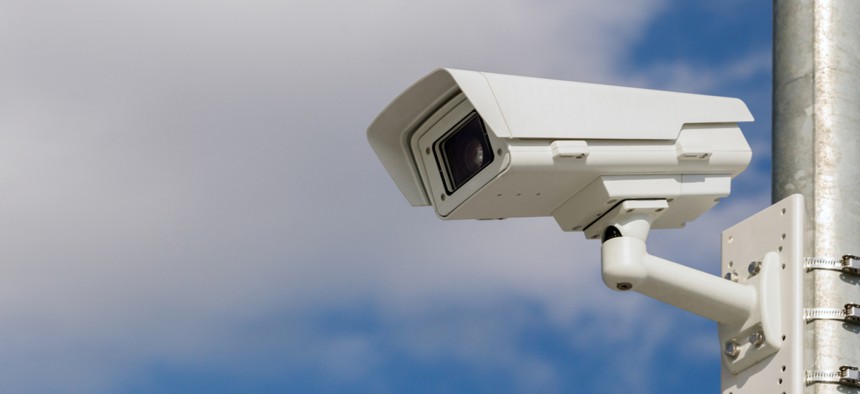Six U.S. Cities Make the List of Most Surveilled Places in the World

Offline surveillance by the government has grown exponentially in the past few years. Shutterstock
A new report found that CCTV surveillance is increasing in certain areas of the U.S., with one city government watching its citizens from 35,000 cameras.
Conversations about privacy concerns in recent years have often focused on the online space, given high profile data breaches and repeated revelations of tech companies’ misuse of personal information. But the private sector isn’t alone in surveilling people, and invasions of privacy aren’t just threats online.
Offline surveillance by the government has grown exponentially in the past few years. One estimate found that the number of security cameras in the U.S. grew from 33 million in 2012 to 62 million in 2016. Now, a new report from Comparitech, a technology research firm, takes a count of the number of closed-circuit television cameras owned by both government and private sources in cities around the world and compares that with the city’s population to find the density of cameras.
Atlanta was the only place in the U.S. to crack the top ten, with 15.56 cameras per thousand residents. That may seem low compared to cities higher on the list, most of which are in China and have 39 to 168 cameras per thousand residents, but Atlanta’s rate is high by U.S. standards. The five other municipalities that made the list of the top 50 most surveilled cities in the world included Chicago, Washington D.C., San Francisco, San Diego, and Boston.
Chicago has about 13 cameras per thousand residents, and D.C. has 5.6. The other three cities have three or less cameras per thousand residents. Chicago had the highest number of individual cameras amongst U.S. cities, at 35,000.
Kenneth Johnson, police commander of the Englewood district in Chicago, said that residents shouldn’t be concerned about privacy because the cameras are out in the open in public places. “This isn’t a secret. This isn’t an Orwellian ‘Big Brother,’” he told the New York Times last year.
Police departments use the cameras in their cities in different ways. San Diego police don’t constantly monitor feeds, but instead use cameras in individual cases, saying they have utilized video to solve 164 crimes since August 2018. Atlanta’s police department, by contrast, has a Video Integration Center that monitors a network of cameras 24 hours a day, 7 days a week. Over 90% of those cameras aren’t actually owned by the city, but are integrated from a number of public and private sources.
Atlanta Sgt. John Chafee told Route Fifty that cameras “play a vital role” in keeping the city safe, and that the police department plans to expand the number of cameras they are currently monitoring. “Access to these cameras multiplies the number of eyes we have on the street looking for criminal activity and assisting with situational awareness during large events and gatherings,” he said. “They allow us to identify criminal activity as it is occurring, prevent and deter criminal activity, and capture video evidence when a crime does occur to aid in criminal investigations and prosecutions.”
Privacy rights groups, including the Anti Surveillance Coalition, have said that there isn’t enough public input when it comes to how police use cameras. "I understand that there may be benefits to crime prevention, but the point is, we have rights and until we talk about privacy rights and our concerns, then we can't have the rest of the conversation," Genevieve Jones-Wright of the ASC told NBC San Diego.
Whether the rest of Americans actually care about living in a surveillance state is another matter. A recent study by the Pew Research Center found that over half of people surveyed trust law enforcement to use facial recognition technology responsibly. That study found clear segmentations along demographic lines, though, as Democrats were less willing to accept facial recognition than Republicans, and black and Hispanic adults were less tolerant of its use by police than white adults. The results also showed a generational gap, with young adults who have grown up with technology finding surveillance more acceptable.
As security cameras evolve into a natural part of the urban landscape, some city leaders are passing legislation to regulate them, ensuring that law enforcement can’t use them with more invasive technologies like facial recognition. In 2019, three cities banned government agencies from using facial recognition, and all three are known for their tech scenes: San Francisco was the first, followed by Somerville, Massachusetts, and later Oakland, California.
There is also a coinciding push at the federal level to regulate the use of facial recognition by private companies. In a bill introduced in the Senate this year, companies would be required to obtain affirmative consent from consumers before deploying the technology in their cameras, but federal, state, and local governments would be exempt, including all law enforcement agencies at those levels.
Already, local law enforcement has found partnerships to expand their surveillance networks beyond just CCTV cameras. More than 400 cities have partnerships with Amazon to use Ring Doorbell footage to aid in solving crimes.
But law enforcement in some cities may soon find it harder to make new partnerships or invest in further surveillance. The ACLU is leading a legislative push at the local level called Community Control Over Police Surveillance, an effort to ensure that city councils have regulatory power over surveillance technologies. The group says this is important because in most cities, the public and elected officials are unaware when police departments start using surveillance tech.
Emma Coleman is the assistant editor for Route Fifty.
NEXT STORY: As Trump Moves to Revoke California Emissions Authority, State Leaders Poised to Challenge






